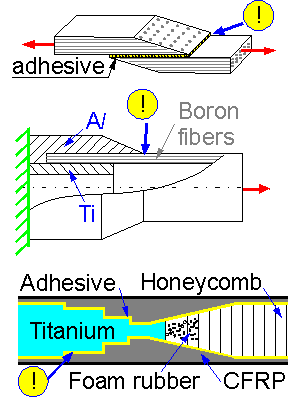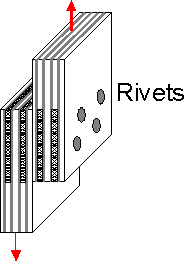 |
Главная |
FATIGUE AND TEMPERATURE EFFECT
|
из
5.00
|
 Composites demonstrate a high resistance to fatigue crack growth. The fatigue strength of many composite materials is higher than for aluminum alloys.
Composites demonstrate a high resistance to fatigue crack growth. The fatigue strength of many composite materials is higher than for aluminum alloys.
 At the first stage of cycling the В«weakВ» fibers are broken. The composite does not fail at this stage due to redundancy of strength. Delaminations and microstructural bond damages occur over a long period of time. At the final stage, the number of broken fibers increases catastrophically.
At the first stage of cycling the В«weakВ» fibers are broken. The composite does not fail at this stage due to redundancy of strength. Delaminations and microstructural bond damages occur over a long period of time. At the final stage, the number of broken fibers increases catastrophically.
 Industrial fibers are less sensitive to high temperature than epoxy or plastics. Carbon fibers demonstrate unique properties.
Industrial fibers are less sensitive to high temperature than epoxy or plastics. Carbon fibers demonstrate unique properties.
Zone of non-linear deformation in the crack tip - zone of plasticity occurs in the matrix only.
 Creep rate increases as nominal stress increases. The ductility of the matrix contributes significantly to the creep effect. Reinforcement by strong and rigid fibers along the direction of the force leads to higher creep strength.
Creep rate increases as nominal stress increases. The ductility of the matrix contributes significantly to the creep effect. Reinforcement by strong and rigid fibers along the direction of the force leads to higher creep strength.
 Glass fiber becomes more brittle and weaker at the В«explosiveВ» deformation rate - small values of the parameter.
Glass fiber becomes more brittle and weaker at the В«explosiveВ» deformation rate - small values of the parameter.
 Water absorption of glass-filled thermoplastics decreases as glass content increases. Water absorption decreases strength of the composite.
Water absorption of glass-filled thermoplastics decreases as glass content increases. Water absorption decreases strength of the composite.
RELIABILITY
 A specific feature of composites is high scatter in strength of strong fibers. Composites usually have lower average strength and scatter in comparison to fibers.
A specific feature of composites is high scatter in strength of strong fibers. Composites usually have lower average strength and scatter in comparison to fibers.
 For constant average strength and higher scatter there is a higher probability that microcracks in the weakest fibers are surrounded by strong fibers. Strength of such composites is usually high.
For constant average strength and higher scatter there is a higher probability that microcracks in the weakest fibers are surrounded by strong fibers. Strength of such composites is usually high.
 Higher average strengths correspond to higher scatter in experimental data. This rule is valid for fibers and composite materials.
Higher average strengths correspond to higher scatter in experimental data. This rule is valid for fibers and composite materials.
 If probability of fracture of a fiber with length lo is 0.5, then probability of failure of a longer fiber is higher. Fibers with longer length have lower strength. Composite series-parallel structures do not decrease the strength to zero due to strength redundancy of parallel elements.
If probability of fracture of a fiber with length lo is 0.5, then probability of failure of a longer fiber is higher. Fibers with longer length have lower strength. Composite series-parallel structures do not decrease the strength to zero due to strength redundancy of parallel elements.
Probability of failure of a series structure composed of similar elements (fibers) is higher than that for a parallel structure:
P1 > P2.
 The average strength of a composite is less than the average strength of its fiber. At low stress, the probability of fracture of a composite (series-parallel system) is lower than for fibers.
The average strength of a composite is less than the average strength of its fiber. At low stress, the probability of fracture of a composite (series-parallel system) is lower than for fibers.
 Experimental data shows that the condition of penetration of a flying body depends on its mass and velocity. The damage decreases fatigue strength of the laminate.
Experimental data shows that the condition of penetration of a flying body depends on its mass and velocity. The damage decreases fatigue strength of the laminate.
 Cyclic loading (fatigue microdamage) decreases the remaining static strength of a composite structure.
Cyclic loading (fatigue microdamage) decreases the remaining static strength of a composite structure.
JOINTS
 There is high stress concentration in the lap joint. It can be decreased if the Young's modulus of the adhesive decreases at the edges.
There is high stress concentration in the lap joint. It can be decreased if the Young's modulus of the adhesive decreases at the edges.
 Stress concentration is smaller for a В«smoothВ» transition from one structural element (adherent) to another.
Stress concentration is smaller for a В«smoothВ» transition from one structural element (adherent) to another.
 Stress concentration is higher at a more rigid material. Proper laminar orientation can decrease the stress concentration.
Stress concentration is higher at a more rigid material. Proper laminar orientation can decrease the stress concentration.
 The joint's bond surface must be sufficiently larger than it's cross-sectional area. The joint can be reinforced by fabric fibers.
The joint's bond surface must be sufficiently larger than it's cross-sectional area. The joint can be reinforced by fabric fibers.
 Manufacturing defects in the adhesive can decrease strength of joints and can be detected by nondestructive testing. The following are examples of some defects:
Manufacturing defects in the adhesive can decrease strength of joints and can be detected by nondestructive testing. The following are examples of some defects:
A. Matrix cure is caused by incorrect mixing or thermal exposure.
B. Disbond or zero-volume unbond is caused by incorrect surface preparation.
C. Voids can be caused by air entrapment.
D. Porosity is associated with volatiles and entrained gases.
E. Adhesive cracks can be caused by thermal shrinkage during manufacturing.
 Composite honeycomb structures have high flexural stiffness and strength. Defects decrease flexural and compressive strength of honeycomb structures:
Composite honeycomb structures have high flexural stiffness and strength. Defects decrease flexural and compressive strength of honeycomb structures:
A. Core damage.
B. Skin imperfection.
C. Lack of adhesive.
D. Improperly formed adhesive fillet.
 Rivets are widely used in composite skin connection. Strength of rivet joints can be increased by increasing the number of smaller rivets and/or by metal foil reinforcement.
Rivets are widely used in composite skin connection. Strength of rivet joints can be increased by increasing the number of smaller rivets and/or by metal foil reinforcement.
 Connection of the composite tubes can be made by elastic deformation in the composites. Filament winding increases the carrying ability of the joint.
Connection of the composite tubes can be made by elastic deformation in the composites. Filament winding increases the carrying ability of the joint.
MATERIAL SELECTION
 Advanced composite materials have unique mechanical properties in comparison with steel or aluminum alloys: fatigue strength, specific strength (ratio of strength to weight), specific rigidity (ratio of modulus of elasticity to weight), strength redundancy and high resistance of damaged structures to external loads. Contrary to metals, crack resistance of modern composite materials increase as strength increases. Crack resistance of composite materials depends on fiber tensile strength, its scatter, matrix tensile strength, and bond shear strength. Splitting of the bond between matrix and fiber helps material to stop macrocracks.
Advanced composite materials have unique mechanical properties in comparison with steel or aluminum alloys: fatigue strength, specific strength (ratio of strength to weight), specific rigidity (ratio of modulus of elasticity to weight), strength redundancy and high resistance of damaged structures to external loads. Contrary to metals, crack resistance of modern composite materials increase as strength increases. Crack resistance of composite materials depends on fiber tensile strength, its scatter, matrix tensile strength, and bond shear strength. Splitting of the bond between matrix and fiber helps material to stop macrocracks.
 Unique properties of a composite can be obtained by proper choice of filament, fiber content, layer orientation, etc.
Unique properties of a composite can be obtained by proper choice of filament, fiber content, layer orientation, etc.
 The use of composite materials decreases the weight of a passenger airplane by 20 - 40%.
The use of composite materials decreases the weight of a passenger airplane by 20 - 40%.
Use of composite materials decreases cost of many engineering structures. Fiber content increase does not excessively raise the cost of the composite.
 One of the most important stages of composite structure manufacturing is nondestructive testing:
One of the most important stages of composite structure manufacturing is nondestructive testing:
A. Ultrasonic testing can reveal porosity, voids, incorrect volume fraction, foreign inclusions, translaminar cracks, delaminations, disbonds in adhesive, poor fillet in honeycomb construction.
B. Eddy currents technique is limited to materials with a conducting phase.
C. Thermography can be used as rapid technique for inspecting large-scale composite structures.
D. Holography is very expensive technique with restricted list of discovered defects, such as disbonding and delamination.
E. Radiography is used in testing of boron or glass reinforced composites, not carbon fiber reinforced composites.
Ultrasonic testing is the most widely used technique for many composite materials.
Group fiber breakage is the most dangerous defect in a composite. It can be revealed by one of the nondestructive methods from the above list.
REFERENCES
Handbook of Composites Ed. by G. Lubin, Van Nostrand Reinhold Company, 1982.
Composite Materials Ed. by L.J. Broutman and R.H.Krock, Academic Press, Volumes 1-8, 1973-1976.
Kelly A., Macmillan N.H. Strong Solids, Oxford Science Publications, 1986.
Damage in Composite Materials Ed. by G.Z. Voyaljis, Elsevier, New York, 1993.
Design With Advanced Composite Materials Ed. by L.N.Phillips, Design Council, Springer, 1989.
Chou, Tsu-Wei Microstructural Design of Fiber Composites, Cambridge University Press, 1992.
THEMES
Theme 1. Stress Concentration
Theme 2. Fracure Mechanics
Theme 3. Mechanical Properties
Theme 4. Strength of Materials
Theme 5. Theory of Elasticity
Theme 6. Structural Safety
Theme 7. Material Science
Theme 8. Welds
Theme 9.Composite Materials
Theme 10. Finite Element Analysis
|
из
5.00
|
Обсуждение в статье: FATIGUE AND TEMPERATURE EFFECT |
|
Обсуждений еще не было, будьте первым... ↓↓↓ |

Почему 1285321 студент выбрали МегаОбучалку...
Система поиска информации
Мобильная версия сайта
Удобная навигация
Нет шокирующей рекламы

